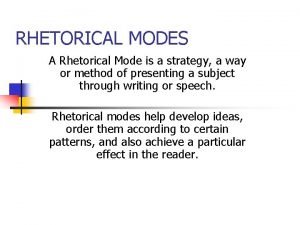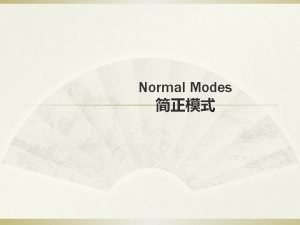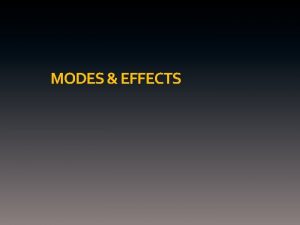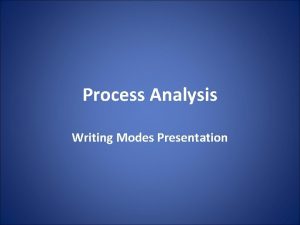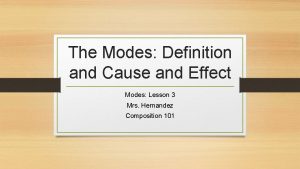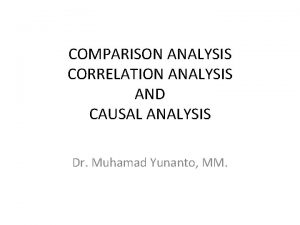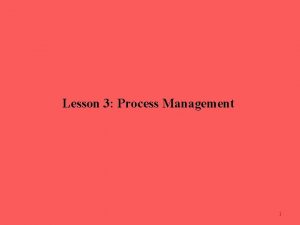The Modes Process Analysis and Comparison Modes Lesson

















- Slides: 17

The Modes: Process Analysis and Comparison Modes: Lesson 2 Mrs. Hernandez

What is a Process Analysis? • A Process Analysis deals with steps. The main kinds of processes explain • how to do something or perform an action • how something works Ex. By carefully preparing for a vacation in a foreign country, travelers can save time and prevent hassles. (how to) Ex. Advertisers often appeal to the emotions of the audience for whom a product is targeted; some of these appeals may be unethical. (how it works) • Process Analyses are exercises in order and detail.

Two Types of Process Analysis • How-to • A “how-to” type of process explain in specific instructions how to perform an activity. Every step is detailed. • How to change a tire • How to create a webpage • How-it-works • A “how-it-works” type of process presents the activity clearly enough so that people understand the process but does not give step-by-step instructions on how to perform an action; it explains what people need to know about something. • How a person wins prizes from a radio station

Point of View for processes • 2 nd person • You can use 2 nd person if you are giving a person specific instructions to follow. • • 3 rd person • • “First, unscrew the adhesive. ” You do not have to talk about a process in 2 nd person, and some instructors will not let you use the word “you” anyway. For these times, use “he” or “a person. ” 1 st person • You are couching your process analysis in a narrative and are talking about a process you have performed and how you went through that process. • • • How I learned to drive How I became really good at baseball The steps I took to do better in a hard class

Parts of a Process Analysis: Thesis • Your thesis statement will be explicit (you will have a sentence specifically to tell the reader what the essay is about). • For your thesis statement, you will need to have a topic (like always) and you will need to express why we need to know the process you are describing. Remember, no one cares about a process that does not have a point. • Thesis = topic + importance • Ex. We may find that we need to “encourage” a roommate to move out simply to preserve our own sanity. § The process we are discussing is how to make a roommate move out. § The reason we are discussing this process is because we need to preserve our own sanity.

Parts of a process analysis: Organization • The organization of a process analysis depends on what you are trying to achieve, but generally it will be chronological (because you have to tell events in order). • There are no exceptions to this for a “how-to” process analysis. • For a how it works essay, you may find that an emphatic, or order of importance, organization will work.

Parts of a process analysis: Remember to do these things! • 1. Provide background information. Sometimes a reader may need explanation of a subject before you tell them about the process. • 2. If there are items that will be necessary, tell the reader that before they start attempting to perform an action. • 3. Explain terms that the reader might not know, especially if they are technical or unfamiliar. • 4. Write careful and adequate details. This will depend largely on the type of audience you are writing to. Do they know a lot about your subject or a little? • 5. Anticipate problems that your reader may come across AND warn them of them. Provide solutions that will help ease your reader through the trouble. • 6. YOUR PROCESS MUST ALSO HAVE A POINT—why are you describing this process? If you do not know, your reader will not either.

How to use process analysis • Process analysis can stand on its own. If you need to write an essay giving instructions or telling someone how something works, then this is your go-to mode. • However, sometimes you are writing an essay where you need a process but that is not the focus. Here is what you should do: • 1. Provide a brief summary or overview of the process rather than the whole thing. Too much detail will confuse your reader about your primary mode. • 2. Make it clear why the process is included. Don’t just add it to fill space. And use a transition. • 3. Helpful words you can use to show that a process is include is “procedure” or “process. ” • 4. When you have completed the process analysis, let readers know you are about to return to the primary mode. Transition, transition.

What is a Comparison? A comparison is a type of essay that looks at both the SIMILARITIES and DIFFERENCES between two or more subjects. This type of essay is also called a “comparison and contrast” essay. Sometimes, an essay can focus on both comparison and contrast, but most successful short essays focus on one or the other.

Organization of a comparison • Most comparison essays will be structured emphatically (by importance). More specifically, comparison essays have two ways to organize: • Point-by-point • The writer moves back and forth between both subjects being examined; the primary organization is by point • Subject-by-subject • The writer discusses all the points of one subject before moving on to discuss all the same points of the second subject

Examples Side By Side Point By Point • Madonna and Lady Gaga are both popular singers in their own right due to their distinctive voices, fashions, and ability to generate press. • Madonna • Voice, Fashion, and Press • Gaga • Voice, Fashion, and Press singers in their own right due to their distinctive voices, fashions, and ability to generate press. • Voice • • Fashion • • Madonna and Gaga Press • Madonna and Gaga

Rhetorical Situation • Purpose • To differentiate between or attribute similar characteristics to • TO MAKE A POINT • To examine or prove • Point of view • Third person (formal) • Do not use 1 st or 2 nd person

Comparison Thesis Statements Thesis statements for comparisons need to include the two subjects being discussed, the basis of comparison, and the points of comparison. § Basis of comparison—a broad common characteristic on which to base the essay § Points of comparison—characteristics relating to the basis of comparison (more specific points that fall under the basis of comparison)

Example During high school and college, students must navigate three main areas of personal responsibility: life skills, finances, and education. (Forecasting) While three areas remain the same, the level of responsibility in each increases as students transition from high school to college. (Thesis) • In the above example thesis, the two topics being compared are high school and college. • The basis of comparison is responsibility. • The three points of comparison that we will look at in the essay are life skills, finances, and education. • It is understood, then, that the writer will discuss how responsibility (or the show of) plays out in high school and college as it pertains to life skills, finances, and education.

Example Thesis Statements • Similar appeals in commercials for three popular breakfast cereals reveal America’s obsession with fitness and health. • Focus: on similarities • Topics: three cereals (though best to be specific) • Purpose: to reveal or show • Although different in purpose, weddings and funerals each draw families together and confirm family values. • Focus: Contrast and Similarities • Topics: Weddings and Funerals • Purpose: to highlight differences and similarities

Parts of a Comparison • Make sure to have sufficient number of characteristics and details. • Have a focus. Focus on similarities, differences, or both. What you choose will depend on your topics. • Make a point. Like always, there has to be a reason for why you are writing your comparison. • Don’t be biased. Be equal in your evaluation even if you are choosing one topic over the other. Do not shortchange your evaluation.

How to use comparison • A comparison paper can stand by itself. • However, if you want to use it in other modes, remember to • Determine the purpose of your comparison. What will it bring to your essay. • Keep the comparison short and to the point, especially if it is not the focus of your essay. • Organize the points of comparison. Follow on of the ways to organize for comparison. • Use transitions! (Transitions, transitions. ) Introduce the comparison clearly and also transition away from it when done.
 Direct comparison test
Direct comparison test Rhetorical modes in writing
Rhetorical modes in writing Hát kết hợp bộ gõ cơ thể
Hát kết hợp bộ gõ cơ thể Bổ thể
Bổ thể Tỉ lệ cơ thể trẻ em
Tỉ lệ cơ thể trẻ em Voi kéo gỗ như thế nào
Voi kéo gỗ như thế nào Chụp phim tư thế worms-breton
Chụp phim tư thế worms-breton Chúa yêu trần thế
Chúa yêu trần thế Môn thể thao bắt đầu bằng từ đua
Môn thể thao bắt đầu bằng từ đua Thế nào là hệ số cao nhất
Thế nào là hệ số cao nhất Các châu lục và đại dương trên thế giới
Các châu lục và đại dương trên thế giới Công thức tính độ biến thiên đông lượng
Công thức tính độ biến thiên đông lượng Trời xanh đây là của chúng ta thể thơ
Trời xanh đây là của chúng ta thể thơ Mật thư tọa độ 5x5
Mật thư tọa độ 5x5 Làm thế nào để 102-1=99
Làm thế nào để 102-1=99 độ dài liên kết
độ dài liên kết Các châu lục và đại dương trên thế giới
Các châu lục và đại dương trên thế giới

